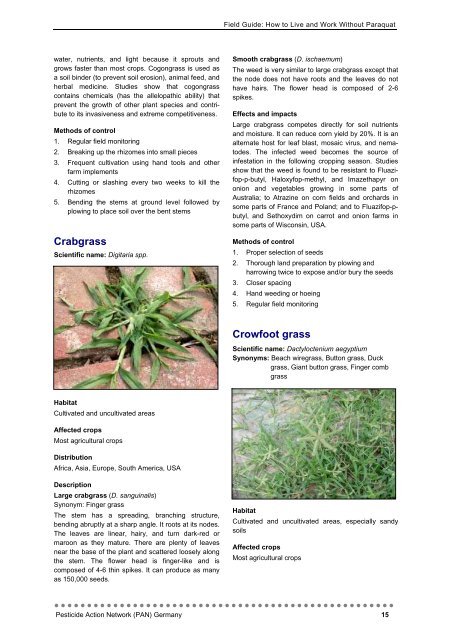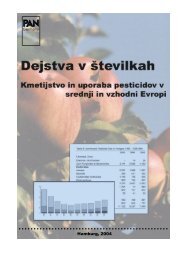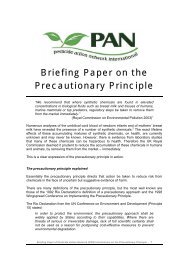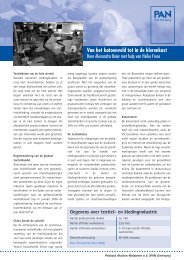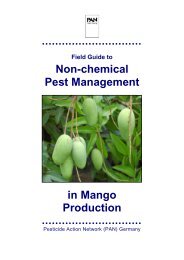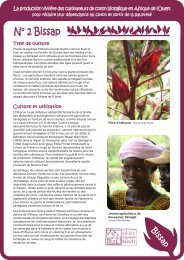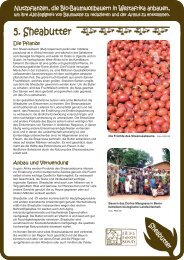Field Guide: How to Grow Crops without Paraquat - Online ...
Field Guide: How to Grow Crops without Paraquat - Online ...
Field Guide: How to Grow Crops without Paraquat - Online ...
You also want an ePaper? Increase the reach of your titles
YUMPU automatically turns print PDFs into web optimized ePapers that Google loves.
<strong>Field</strong> <strong>Guide</strong>: <strong>How</strong> <strong>to</strong> Live and Work Without <strong>Paraquat</strong><br />
water, nutrients, and light because it sprouts and<br />
grows faster than most crops. Cogongrass is used as<br />
a soil binder (<strong>to</strong> prevent soil erosion), animal feed, and<br />
herbal medicine. Studies show that cogongrass<br />
contains chemicals (has the allelopathic ability) that<br />
prevent the growth of other plant species and contribute<br />
<strong>to</strong> its invasiveness and extreme competitiveness.<br />
Methods of control<br />
1. Regular field moni<strong>to</strong>ring<br />
2. Breaking up the rhizomes in<strong>to</strong> small pieces<br />
3. Frequent cultivation using hand <strong>to</strong>ols and other<br />
farm implements<br />
4. Cutting or slashing every two weeks <strong>to</strong> kill the<br />
rhizomes<br />
5. Bending the stems at ground level followed by<br />
plowing <strong>to</strong> place soil over the bent stems<br />
Crabgrass<br />
Scientific name: Digitaria spp.<br />
Smooth crabgrass (D. ischaemum)<br />
The weed is very similar <strong>to</strong> large crabgrass except that<br />
the node does not have roots and the leaves do not<br />
have hairs. The flower head is composed of 2-6<br />
spikes.<br />
Effects and impacts<br />
Large crabgrass competes directly for soil nutrients<br />
and moisture. It can reduce corn yield by 20%. It is an<br />
alternate host for leaf blast, mosaic virus, and nema<strong>to</strong>des.<br />
The infected weed becomes the source of<br />
infestation in the following cropping season. Studies<br />
show that the weed is found <strong>to</strong> be resistant <strong>to</strong> Fluazifop-p-butyl,<br />
Haloxyfop-methyl, and Imazethapyr on<br />
onion and vegetables growing in some parts of<br />
Australia; <strong>to</strong> Atrazine on corn fields and orchards in<br />
some parts of France and Poland; and <strong>to</strong> Fluazifop-pbutyl,<br />
and Sethoxydim on carrot and onion farms in<br />
some parts of Wisconsin, USA.<br />
Methods of control<br />
1. Proper selection of seeds<br />
2. Thorough land preparation by plowing and<br />
harrowing twice <strong>to</strong> expose and/or bury the seeds<br />
3. Closer spacing<br />
4. Hand weeding or hoeing<br />
5. Regular field moni<strong>to</strong>ring<br />
Crowfoot grass<br />
Scientific name: Dactyloctenium aegyptium<br />
Synonyms: Beach wiregrass, But<strong>to</strong>n grass, Duck<br />
grass, Giant but<strong>to</strong>n grass, Finger comb<br />
grass<br />
Habitat<br />
Cultivated and uncultivated areas<br />
Affected crops<br />
Most agricultural crops<br />
Distribution<br />
Africa, Asia, Europe, South America, USA<br />
Description<br />
Large crabgrass (D. sanguinalis)<br />
Synonym: Finger grass<br />
The stem has a spreading, branching structure,<br />
bending abruptly at a sharp angle. It roots at its nodes.<br />
The leaves are linear, hairy, and turn dark-red or<br />
maroon as they mature. There are plenty of leaves<br />
near the base of the plant and scattered loosely along<br />
the stem. The flower head is finger-like and is<br />
composed of 4-6 thin spikes. It can produce as many<br />
as 150,000 seeds.<br />
Habitat<br />
Cultivated and uncultivated areas, especially sandy<br />
soils<br />
Affected crops<br />
Most agricultural crops<br />
••••••••••••••••••••••••••••••••••••••••••••••••••••<br />
Pesticide Action Network (PAN) Germany 15


